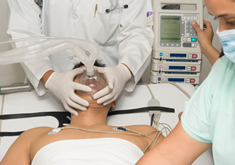¿Tratamiento conservador o quirúrgico? | 14 ABR 14
Manejo actual del trauma esplénico
Un enfoque basado en evidencias que permite evaluar, clasificar y tratar los distintos tipos de truama esplénico cerrado.

- ↵Costa G, Tierno SM, Tomassini F, Venturini L, Frezza B, Cancrini G, et al. The epidemiology and clinical evaluation of abdominal trauma: an analysis of a multidisciplinary trauma registry. Ann Ital Chir2010;81:95-102.Medline
- ↵Aubrey-Bassler FK, Sowers N. 613 cases of splenic rupture without risk factors or previously diagnosed disease: a systematic review. BMC Emerg Med2012;12:11.CrossRefMedline
- ↵Gutierrez G, Reines HD, Wulf-Gutierrez ME. Clinical review: hemorrhagic shock. Crit Care2004;8:373-81.CrossRefMedlineWeb of Science
- ↵Schurink GW, Bode PJ, van Luijt PA, van Vugt AB. The value of physical examination in the diagnosis of patients with blunt abdominal trauma: a retrospective study. Injury1997;28:261-5.CrossRefMedlineWeb of Science
- ↵Schneir A, Holmes JF. Clinical findings in patients with splenic injuries: are injuries to the left lower chest important? Cal J Emerg Med2001;2:33-6.Medline
- ↵Kortbeek JB, Al Turki SA, Ali J, Antoine JA, Bouillon B, Brasel K, et al. Advanced trauma life support, 8th edition, the evidence for change. J Trauma2008;64:1638-50.CrossRefMedlineWeb of Science
- ↵Boulanger BR, Kearney PA, Brenneman FD, Tsuei B, Ochoa J. Utilization of FAST (focused assessment with sonography for trauma) in 1999: results of a survey of North American trauma centers. Am Surg2000;66:1049-55.MedlineWeb of Science
- ↵Rothlin MA, Naf R, Amgwerd M, Candinas D, Frick T, Trentz O. Ultrasound in blunt abdominal and thoracic trauma. J Trauma1993;34:488-95.CrossRefMedlineWeb of Science
- ↵Stengel D, Bauwens K, Sehouli J, Porzsolt F, Rademacher G, Mutze S, et al. Systematic review and meta-analysis of emergency ultrasonography for blunt abdominal trauma. Br J Surg2001;88:901-12.CrossRefMedlineWeb of Science
- ↵Shuman WP, Ralls PW, Balfe DM, Bree RL, DiSantis DJ, Glick SN, et al. Imaging of blunt abdominal trauma. American College of Radiology: ACR appropriateness criteria. Radiology2000;215(suppl):143-51.Medline
- ↵Smith J. Focused assessment with sonography in trauma (FAST): should its role be reconsidered? Postgrad Med J2010;86:285-91.Abstract/FREE Full Text
- ↵Laselle BT, Byyny RL, Haukoos JS, Krzyzaniak SM, Brooks J, Dalton TR, et al. False-negative FAST examination: associations with injury characteristics and patient outcomes. Ann Emerg Med2012;60:326-34.e3.CrossRefMedline
- ↵Barquist ES, Pizano LR, Feuer W, Pappas PA, McKenney KA, LeBlang SD, et al. Inter- and intrarater reliability in computed axial tomographic grading of splenic injury: why so many grading scales? J Trauma2004;56:334-8.CrossRefMedlineWeb of Science
- ↵Federle MP, Griffiths B, Minagi H, Jeffrey RB Jr. Splenic trauma: evaluation with CT. Radiology1987;162:69-71.MedlineWeb of Science
- ↵Scatamacchia SA, Raptopoulos V, Fink MP, Silva WE. Splenic trauma in adults: impact of CT grading on management. Radiology1989;171:725-9.MedlineWeb of Science
- ↵Brasel KJ, DeLisle CM, Olson CJ, Borgstrom DC. Splenic injury: trends in evaluation and management. J Trauma1998;44:283-6.CrossRefMedlineWeb of Science
- ↵Royal College of Radiologists. Standards of practice and guidance for trauma radiology in severely injured patients. Royal College of Radiologists, 2011.
- ↵Boscak AR, Shanmuganathan K, Mirvis SE, Fleiter TR, Miller LA, Sliker CW, et al. Optimizing trauma multidetector CT protocol for blunt splenic injury: need for arterial and portal venous phase scans. Radiology2013;268:79-88.CrossRefMedlineWeb of Science
- ↵Shapiro MJ, Krausz C, Durham RM, Mazuski JE. Overuse of splenic scoring and computed tomographic scans. J Trauma1999;47:651-8.CrossRefMedlineWeb of Science
- ↵Mirvis SE, Whitley NO, Gens DR. Blunt splenic trauma in adults: CT-based classification and correlation with prognosis and treatment. Radiology1989;171:33-9.MedlineWeb of Science
- ↵Rating the severity of tissue damage: I. The abbreviated scale. JAMA1971;215:277-80.CrossRefMedlineWeb of Science
- ↵Moore EE, Moore FA. American Association for the Surgery of Trauma Organ Injury Scaling: 50th anniversary review article of the Journal of Trauma. J Trauma2010;69:1600-1.CrossRefMedline
- ↵Moore EE, Shackford SR, Pachter HL, McAninch JW, Browner BD, Champion HR, et al. Organ injury scaling: spleen, liver, and kidney. J Trauma1989;29:1664-6.CrossRefMedlineWeb of Science
- ↵Moore EE, Cogbill TH, Jurkovich GJ, Shackford SR, Malangoni MA, Champion HR. Organ injury scaling: spleen and liver (1994 revision). J Trauma1995;38:323-4.CrossRefMedlineWeb of Science
- ↵Marmery H, Shanmuganathan K, Alexander MT, Mirvis SE. Optimization of selection for nonoperative management of blunt splenic injury: comparison of MDCT grading systems. AJR Am J Roentgenol2007;189:1421-7.CrossRefMedlineWeb of Science
- ↵Olthof DC, van der Vlies CH, Scheerder MJ, de Haan RJ, Beenen LF, Goslings JC, et al. Reliability of injury grading systems for patients with blunt splenic trauma. Injury2014;45:146-50.CrossRefMedline
- ↵Upadhyaya P, Simpson JS. Splenic trauma in children. Surg Gynecol Obstet1968;126:781-90.MedlineWeb of Science
- ↵Mucha P Jr, Daly RC, Farnell MB. Selective management of blunt splenic trauma. J Trauma1986;26:970-9.CrossRefMedlineWeb of Science
- ↵Longo WE, Baker CC, McMillen MA, Modlin IM, Degutis LC, Zucker KA. Nonoperative management of adult blunt splenic trauma: criteria for successful outcome. Ann Surg1989;210:626-9.CrossRefMedlineWeb of Science
- ↵Peitzman AB, Heil B, Rivera L, Federle MB, Harbrecht BG, Clancy KD, et al. Blunt splenic injury in adults: multi-institutional study of the Eastern Association for the Surgery of Trauma. J Trauma2000;49:177-87, discussion 187-9.CrossRefMedlineWeb of Science
- ↵Garber BG, Mmath BP, Fairfull-Smith RJ, Yelle JD. Management of adult splenic injuries in Ontario: a population-based study. Can J Surg2000;43:283-8.Medline
- ↵Bee TK, Croce MA, Miller PR, Pritchard FE, Fabian TC. Failures of splenic nonoperative management: is the glass half empty or half full? J Trauma2001;50:230-6.CrossRefMedlineWeb of Science
- ↵Velmahos GC, Zacharias N, Emhoff TA, Feeney JM, Hurst JM, Crookes BA, et al. Management of the most severely injured spleen: a multicenter study of the Research Consortium of New England Centers for Trauma (ReCONECT). Arch Surg2010;145:456-60.CrossRefMedlineWeb of Science
- ↵Cirocchi R, Boselli C, Corsi A, Farinella E, Listorti C, Trastulli S, et al. Is non-operative management safe and effective for all splenic blunt trauma? A systematic review. Crit Care2013;17:R185.CrossRefMedline
- ↵Sclafani SJ. The role of angiographic hemostasis in salvage of the injured spleen. Radiology1981;141:645-50.MedlineWeb of Science
- ↵Stassen NA, Bhullar I, Cheng JD, Crandall ML, Friese RS, Guillamondegui OD, et al. Selective nonoperative management of blunt splenic injury: an Eastern Association for the Surgery of Trauma practice management guideline. J Trauma Ac
Comentarios
Para ver los comentarios de sus colegas o para expresar su opinión debe ingresar con su cuenta de IntraMed.
CONTENIDOS RELACIONADOS
Términos y condiciones de uso | Política de privacidad | Todos los derechos reservados | Copyright 1997-2024












